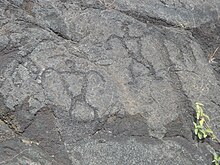
Back Antieke Hawaii Afrikaans هاواي القديمة Arabic Antic Hawaii Catalan Altes Hawaii German Antiguo Hawái Spanish Hawaii Kuno ID ハワイの歴史#先史時代 Japanese 고대 하와이 Korean
| Part of a series on the |
| History of Hawaii |
|---|
| Topics |

Ancient Hawaiʻi is the period of Hawaiian history preceding the unification in 1810 of the Kingdom of Hawaiʻi by Kamehameha the Great. Traditionally, researchers estimated the first settlement of the Hawaiian islands as having occurred sporadically between 400 and 1100 CE by Polynesian long-distance navigators from the Samoan, Marquesas, and Tahiti islands within what is now French Polynesia.[1] In 2010, a study was published based on radiocarbon dating of more reliable samples which suggests that the islands were settled much later, within a short timeframe, in about 1219 to 1266.[2]
The islands in Eastern Polynesia have been characterized by the continuities among their cultures, and the short migration period would be an explanation of this result. Diversified agroforestry and aquaculture provided sustenance for Native Hawaiian cuisine. Tropical materials were adopted for housing. Elaborate temples (called heiau) were constructed from the lava rocks available.
The rich natural resources supported a relatively dense population, organized by a ruling class and social system with religious leaders. Captain James Cook made the first known European contact with ancient Hawaiians in 1778. He was followed by many other Europeans and Americans.
- ^ Fornander, Abraham; Thrum, Thomas G. (1985). Fornander collection of Hawaiian antiquities and folk-lore : the Hawaiian account of the formation of their islands and origin of their race, with the traditions of their migrations, etc. Kraus Reprint. ISBN 0-527-01638-1. OCLC 11676151.
- ^ Cite error: The named reference
fastwas invoked but never defined (see the help page).
© MMXXIII Rich X Search. We shall prevail. All rights reserved. Rich X Search